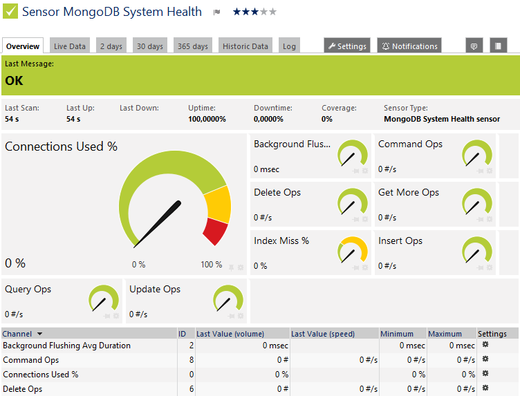Important note: The MongoDB System Health sensor is deprecated as of PRTG version 16.1.23. Please see the following article for more details: The PRTG Sensor Cleanup.
Today's information architecture relies heavily on databases. Whether you use Microsoft SQL, MySQL, PostgreSQL, Oracle SQL or MongoDB—the health of your database server is an essential value to monitor in order to guarantee fast and reliable database access. After having already presented the WMI Microsoft SQL Server sensor, in this blog article you'll learn about how you can monitor your MongoDB server with PRTG Network Monitor.
The MongoDB System Health Sensor uses the Hypertext Transfer Protocol (HTTP) and the MongoDB admin web console to read information about connections and operations, which is the basis for monitoring data on the health status of your MongoDB server. In detail, this sensor type provides you with information on the following values:
- Percentage of used connections,
- Percentage of index misses,
- Average duration of background flushing,
- Command operations per second,
- Delete operations per second,
- Insert operations per second,
- Update operations per second,
- Query operations per second, and
- Get more operations per second.
If you have integrated MongoDB in your IT infrastructure, just take this sensor type for a spin! For more information on how to configure it, just have a look at the PRTG manual chapter on the MongoDB System Health sensor. Let's keep your MongoDB server healthy!
All Sensors of the Week
You have missed other articles of our "Sensors of the Week" blog series? You have missed other articles of our "Sensors of the Week" blog series? Just take a look at the last 10 sensors:
- Packet Sniffer sensor
- Hyper-V Virtual Storage Device sensor
- SSH Disk Free sensor
- SSH Script Advanced sensor
- Cloud HTTP sensor
- SNMP Juniper NS System Health sensor
- Cloud Ping sensor
- SNMP Cisco UCS Blade sensor
- MongoDB System Health sensor
- SNMP Custom Advanced Sensor
Subscribe to our RSS feed to always stay up to date on new articles!
If you like this post, please give it a tweet or a share. It'll only take you one click on the top right of the page. Thanks! :)
 Published by
Published by 













